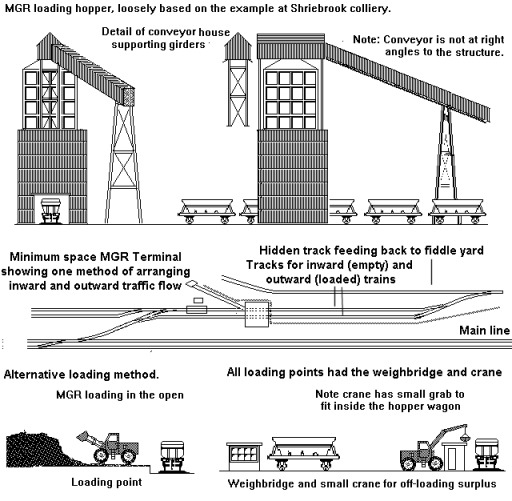Coal mines were always equipped with extensive sidings to hold the coal wagons, which were in effect used as a bunker for buffer stocks of coal to meet fluctuations in demand. This tied up a lot of money in rolling stock and during the Beeching era the Eastern Region of British Railways decided to do something about it. The result was the Merry-go-round (MGR) service, in which the specially designed hopper wagons used never actually stop, only slowing down to pass through the loading and discharging bunkers at each end of the loop.
The very first 'merry-go-round' operation was to Richborough power station, near Sandwich, in the early 1960's. This service used rakes of 24.5t hoppers, fitted with disc brakes, and ran to and from various local collieries where the rake was handled as a block, and so did not require shunting. These wagons had manually operated hopper doors, so the train did have to stop and start at the unloading point and as such was not a true 'merry-go-round' operation. Even so the economies of this type of operation were soon apparent and BR began working on a fully developed MGR system using new purpose built wagons. apparent.
The new Merry-Go-Round HAA hoppers capable of carrying 32 tons of coal and fitted with automatic door opening and closing gear came into operation in 1965 to supply larger industrial users on a true merry-go-round system of operation. The new wagons, originally coded HOP32AB, have a simple mechanical device that opens and closes the bottom doors at the discharge point. It was felt that the simplicity of a mechanical lever system would result in greater reliability for automatic operation, in practice this is the one area where problems have arisen and more modern practice favours power operated discharge doors. A model of the type was available from Minitrix and more recently a model has been produced by Graham Farish.
In the late 1970's a re-springing program was undertaken to improve the loaded speed from 45 mph to 60 mph and the new TOPS code was then HDA. Some wagons in Scotland have been fitted with extensions to the sides and ends to increase capacity and these extensions (to fit the Minitrix wagons, they may fir the Farish type) are available from Bernard Taylor in packs of five. In some duties the HAA wagons proved unsuitable and coke was shipped in old 21 ton vacuum braked HTV's to the end of the 1990's.
The Central Electricity Generating Board, who operated the countries power stations, adopted the MGR concept with enthusiasm as they had experienced difficulties in handling the motley assortment of wagons previously used to deliver the coal. Prior to the MGR service several power stations has used wagon tipplers (either side tipping or end tipping through the end doors of the wagons), however this required the wagons to be uncoupled for tipping, then re-coupled to for a rake of empties. This in turn required a fair bit of siding space.
The National Coal Board, who owned all the coal mines, were less enthusiastic about the new MGR trains as they then had to build expensive loading bunkers able to hold two or three thousand tons of coal. As a result some mines soldiered on with older designs of wagon whilst at others the MGR wagons were operated in the old way being dropped off and collected from exchange sidings and shunted through the coal loading points by NCB steam shunting engines. As recently as the 1980's the Bickershaw Colliery in Lancashire was loading HAA's in short rakes of ten or so at a time, hauling these to and from a series of transfer sidings with small diesels and even an old Austerity 0-6-0 saddle tank. The Austerity tank engine is available from Graham Farish in NCB livery.
Fig___ MGR Loading Arrangements

At the discharge point the train slows down to walking speed as it passes over the bays where the coal is emptied metal brackets called 'daleks' by the staff open and close the bottom doors. The restriction in speed at this point is due to the speed at which the conveyor belts can remove the coal from the discharge bays.
In the late 1980's the shortest MGR haul was only three miles but nation wide the average journey was 30 miles. The average MGR train comprises about 48 wagons and the average wagon shifts in the region of 150 tons per week (a considerable improvement on the one loaded journey every two weeks of the old GWR twenty ton opens). The shortest regular MGR working is about 30 wagons and anything less than about 18-20 looks short in N Gauge.